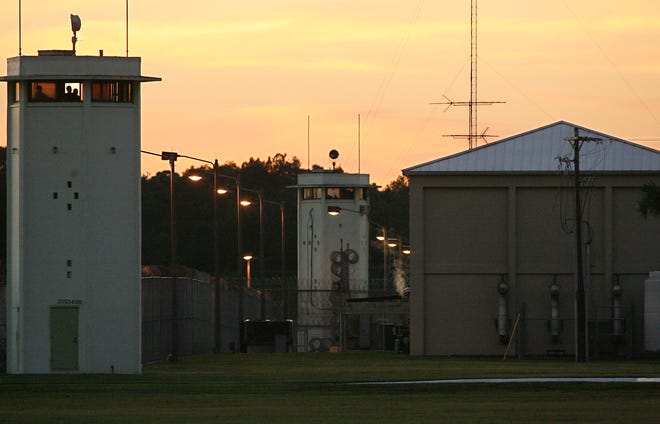
TALLAHASSEE – Florida’s long-troubled prison system – the nation’s third largest – demands between $6.3 billion and $11.9 billion from taxpayers over the next two decades to maintain, modernize and keep up with a forecasted surge of inmates, consultants told a state Senate panel.
While the overall needs are eye-popping, a portion of Wednesday’s review in the Senate Appropriations Committee focused on a smaller component: $582 million to install air-conditioning across the 85,000-inmate system.
Sen. Jonathan Martin, R-Fort Myers, questioned whether such spending was really needed. He said the money might be better spent on salaries and benefits for correctional officers.
“Do you know if instead of air conditioning additional beds for inmates, if that $582 million could be spent to increase salaries and benefits? … Would that make a difference in retention?” Martin, a former prosecutor, asked consultants from KPMG, the firm the Florida Department of Corrections has hired to devise a prison system “master plan.”
75% of state prison housing lacks air-conditioning
Corrections Secretary Ricky Dixon last month testified before lawmakers that 75% of all housing units in Florida’s corrections system do not have air-conditioning.
The KPMG consultants said Wednesday that there are 14,489 corrections officers, and while staff turnover is high, they cautioned against concluding that employee retention could not be improved merely by pay – without air-conditioning.
There are 515 housing units across Florida’s prison system without air-conditioning, although it wasn’t immediately clear how many prison beds are included in those dwellings.
“Logic would tell us that if you give raises, it would have an impact on some. But I’d still say there are many who have walked the floor in those facilities on those 100-plus-degree days, and it’s very difficult,” said Bill Sizic, a KPMG managing director.
KPMG officials also pointed out that by providing air-conditioning across the prison system, Florida would be lowering its risk of class-action lawsuits stemming from having inmates confined without adequate cooling.
Dixon and his department, during weeks of sweltering temperatures earlier this year, took the unusual step of allowing inmates to wear shorts and T-shirts, instead of their uniform long pants, shirts and undershirts.
Conditions ‘unlivable,’ one advocate said
Denise Rock, executive director of Florida Cares Charity Corp., a nonprofit advocacy group for inmates, told the USA Today Network-Florida in August that conditions inside Florida prisons were “unlivable.”
Through the years, the sprawling corrections system has struggled with a host of problems, including gang-related violence, a spike in inmate deaths, skyrocketing health costs and difficulty in hiring and retaining correctional officers, leaving some facilities dangerously short-staffed.
Air-conditioning is just one of the issues facing Florida’s aging prisons; the state’s oldest prison, Union Correctional Institution in Raiford, has been operating since 1913.
KPMG outlined three paths the state could choose among to improve the system, which is on track to swell to between 107,705 and 123,619 inmates in the next 20 years.
The three approaches were dubbed “modernize,” “manage” and “mitigate.”
Sweltering heat hurts inmates‘Unlivable’: Amid Florida heat, advocates decry lack of air conditioning in state prisons
Lawsuit filed against confinementLawsuit seeks to end solitary confinement in Florida prisons
“Modernize” would cost $11.9 billion. It involves the state building three new prisons and two inmate hospitals over the next two decades, while closing four others and expanding bed counts across the system.
The $9 billion “manage” option includes two new prisons and a pair of hospitals; closing three prisons and adding thousands of beds to existing facilities.
Just to “mitigate” involves a $6.3 billion investment over 20 years, adding one new prison and two hospitals, not closing any facilities, and building-up inmate capacity.
Lawmakers begin next year’s legislative session in January, and the prison management plan is expected to emerge as a priority.
Deeper analysis urged before expansion
But Jackie Dunn of Fernandina Beach, founder of the social justice nonprofit Data4Change, said lawmakers should do a deeper evaluation of the state’s current inmate population before embarking on a costly expansion.
Older inmates comprise a significant portion of those behind bars and could be eligible for release or to corrections programs outside of prison without posing a community threat, Dunn said.
“We’ve got a lot of people in there that we’re not afraid of anymore, who we could at least transition to a less expensive type of punishment,” Dunn said.
She also weighed-in on the air-conditioning question.
“These are humans. People would get in trouble if they left their dog in a car while in Wal-Mart without air-conditioning,” she said. “I don’t necessarily think we need to ingratiate people with the luxuries of the outside world, but they are humans. And everyone deserves to be treated humanely.”
John Kennedy is a reporter in the USA TODAY Network’s Florida Capital Bureau. He can be reached at jkennedy2@gannett.com, or on X at @JKennedyReport.
This post was originally published on this site be sure to check out more of their content.








